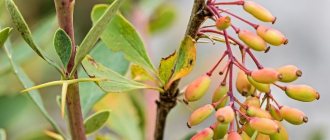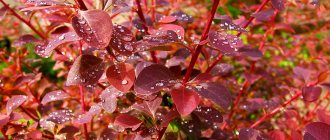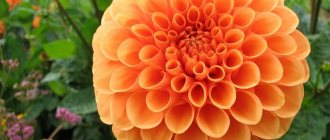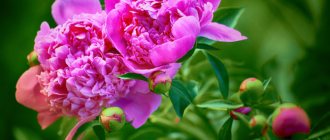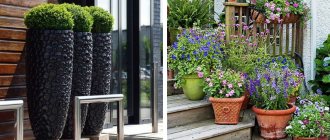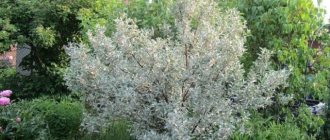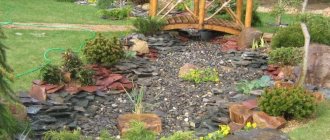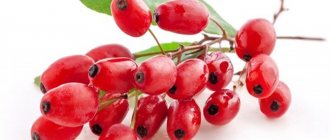If a gardener is faced with the task of creating a hedge with maximum obstruction, the best shrub for this is common barberry. In addition to its thorniness, the plant has a number of other qualities, thanks to which it is often used to decorate the landscape in urban environments, and the fruits are used in cooking and folk medicine.
The shrub bears fruit annually, starting from the age of four
Description of common barberry and characteristics
Common barberry (in Latin Berberis vulgaris) is a deciduous shrub whose homeland is considered to be the Far East. Today, its natural habitat is Central Asia and Europe, North America. The plant can be found on the edges of forests, in the mountains, where it spreads to an altitude of 2000 m.
Depending on the growing conditions, the common barberry has a height of 1.5 m to 2.5 m. The stems are powerful, erect, and highly branched. Their bark is brownish-gray, equipped with spines (up to 2 cm) over the entire surface and bright green elliptical leaves, 5 cm long. The leaf blades are thin, with small jagged edges.
At the end of May, yellow flowers bloom on the common barberry, collected in clusters of 20-25 pieces. Flowering lasts about three weeks, after which fruits set, ripening in the first half of September. The bright scarlet, shiny, oval-shaped berries of barberry, up to 1.2 cm long and weighing 4 g, can stay on the bushes for a long time without falling off even in winter. The fruits are edible, but taste sour.
Common barberry is unpretentious to growing conditions, undemanding to soil composition, and winters well even in regions with a harsh climate. It tolerates shade, but bears fruit better if it is well lit by the sun for most of the daylight hours. It survives pruning and haircut painlessly. It has high immunity, but in damp and cold weather it can be affected by fungal pathologies. The shrub is drought-resistant and tolerates smoke and dust easily.
Where does common barberry grow and how does it bloom?
In the Russian Federation, common barberry is grown in gardens from the Kaliningrad region to Primorye; in nature it can be found in the North-Western region, Crimea, the Caucasus, and Eastern Siberia. The shrub's favorite places are forest edges, lawns, areas of chalk deposits and river pebbles.
Judging by the description and photo, the common barberry looks very decorative during the bud blooming period, the yellow tassels of flowers are numerous, their appearance is elegant and delicate. The shrub is considered an excellent honey plant; during flowering it emits a pleasant aroma that attracts insects.
The annual growth of the bush is 30 cm
Common barberry is no less effective after flowering has ended. By autumn, the foliage gradually turns orange or purple (depending on the variety). It is complemented by bright berries that remain on the branches even in the winter months.
Description
Barberry (the Latin name “ber-beri” means “bear berry”) is a slightly prickly branched shrub up to 1.5-2 m high.
Common barberry, oxalis
One of the characteristic features of common barberry is the yellow color of its wood.
It has a powerful root and woody creeping rhizomes.
The shoots are elongated, bearing 3-5 separate spines, and shortened, with green thin leaves. The bark is greyish.
The leaves are small, elliptical or fraternal, obtuse at the apex, with jagged edges, growing from the base of the spines.
The flowers are bisexual, in drooping racemes, consist of 6, less often 9 yellow sepals, 6 yellow petals, 6 stamens, the superior ovary is unilocular.
They have a peculiar smell. It blooms in May - June, the fruits ripen in August.
Fruit - 2-3 - seeded oblong berry, bright red, oval, up to 1 cm long, with brown seeds, tastes sour, poisonous when unripe . Ripens in August - September. On the Black Sea coast in June
Advantages and disadvantages
The wide distribution and use of common barberry for decorative purposes indicates that the species has undeniable advantages. Its popularity is due to its excellent characteristics and features.
Common barberry does not grow well on acidic, heavy soils
Among the advantages of the variety:
- unpretentiousness of cultivation;
- winter hardiness;
- drought resistance;
- easy tolerability of haircuts and pruning;
- tolerance to air pollution;
- low demands on soil composition;
- decorativeness;
- abundant and long flowering;
- fast growth;
- high immunity;
- the ability to create a reliable hedge;
- use of fruits in cooking and folk medicine.
There are few disadvantages of common barberry, among them:
- bush thorniness;
- susceptibility to rust and powdery mildew;
- decreased fruiting when growing in the shade.
Peculiarities
The name in Latin is Berberis vulgaris, derived from the Arabic word “beri” - a shell whose shape resembles the leaves of a bush.
Any type of soil is suitable for cultivation, since the plant is not particularly picky and produces a harvest even if planted in an area that is not of high quality.
It has increased resistance to hot weather conditions, therefore it grows in areas where a warm climate prevails. There is a large amount on the trunks and shoots, due to which the balance of water resource costs is maintained. In this situation, moisture is absorbed slowly, which minimizes the likelihood of drying out.
Distributed in almost all European countries, it grows in Central Asia, North America, also in the Crimea and the Caucasus, which, according to scientists, are considered the birthplace of culture.
Often used to design parks, gardens and so on. The growth of common barberry grows so much that it is sometimes difficult to distinguish it from the “Amur” one, found in the Far East, where high air temperatures are typical. A feature of the wild analogue is the ability to grow on poor soils, rocky embankments located along the banks of reservoirs.
Reproduction methods
Like many other species, common barberry can be propagated by seeds or vegetatively. The method is chosen depending on the gardener’s capabilities and goals.
Seeds
To obtain planting material, berries are collected in the fall, the pulp is removed, the seeds are washed in a weak solution of potassium permanganate and dried. Sow in prepared furrows in late autumn, planting to a depth of 1-3 cm and covering with a layer of sand. The top of the ridge is mulched with sawdust. In spring, the seeds sprout (about 60%), which are thinned out. Seedlings are grown for two years. After this, the young barberries are transplanted to a permanent place.
You can cut common barberry at any time of the year.
Cuttings
From the middle part of annual shoots of common barberry, cuttings with four to five buds 10-15 cm long are cut. After treatment with a growth stimulator, they are planted at an angle in a substrate of soil and sand, immersed to the depth of three buds. The fact that the cutting has taken root can be judged by the appearance of leaves and new growth.
By layering
The method is simple and convenient. In early spring, an annual shoot is selected, which is bent and pinned to the ground (in a small trench) using wooden staples. It is covered with soil, leaving only the top. A year later, the seedling is separated from the mother barberry and transferred to a new location.
By division
The bush is dug up and divided into parts so that each has at least two shoots and a good root system. The method is very labor-intensive, since the bush is thorny and digging it out is not so easy. A more rational solution may be to use young shoots of barberry.
Important! To obtain a seedling with guaranteed characteristics of the mother plant, the grafting method is used.
Medicinal raw materials
Leaves, roots and berries serve as medicinal raw materials. Leaves are collected during the budding and flowering phase of the plant, discarding those that are sick and damaged by pests. Dry in the shade or under a canopy. The raw material has a peculiar smell and tastes sour. Store in bags in a ventilated area for 3 years. The roots are harvested in spring or autumn by cutting down or digging up the bush. The root system should not be completely used; it is necessary to leave a root cutting 10-15 cm long. For every 10 m2 of barberry thickets, one untouched bush should be preserved. The harvested raw materials are chopped into pieces 10-20 cm long, thoroughly shaken off the soil and rotten and blackened parts are removed. The bark peels off very easily, so it is necessary to lay a tarpaulin or other material so that the raw material does not get lost. Berberine contained in the raw material is highly soluble in water, for this reason the roots are not washed, but dried in a ventilated room or in a dryer at a temperature of 45...50°C, turning over periodically. Store in bags, protecting from dampness, for 3 years.
Planting and caring for common barberry
Like most ornamental trees and shrubs, common barberry is planted in early spring or mid-autumn.
In order for the plant to take root, they follow the following algorithm:
- On the sunny side of the site, pits with a depth of 50-60 cm are prepared.
- Create a drainage layer.
- Humus mixed with garden soil is poured onto it.
- Place the seedling in the center of the planting hole and fill the voids.
- Watered.
Important! When creating a hedge, the distance between plants should not exceed 0.5 m; when creating separate plantings, leave a gap of 1.5 m.
Caring for common barberry is simple. Watering is carried out regularly, avoiding waterlogging of the soil. In case of frequent rains, it is abandoned. To keep the soil around the plant loose and breathable, it is mulched with sawdust, grass and straw. The procedure helps in the fight against weeds.
To maintain the plant in proper shape, a one-time fertilizing in the form of nitrogen fertilizers, which is applied in the spring, at the beginning of the growing season, is sufficient.
Common barberry is tolerant of pruning. It is carried out for sanitary purposes or to create the necessary shape. Be sure to remove old, diseased, damaged shoots or branches that greatly thicken the bush.
The wood of the common barberry is bright yellow inside
Only first-year seedlings need to be prepared for winter by carefully mulching the tree trunk circle and covering the crown with spruce branches or non-woven material. Adult barberries overwinter well without any protection.
Care
You don’t have to devote a lot of time; even a novice amateur summer resident can grow and get a good harvest. There is no need to regularly water the plant, loosen it, weed it, feed it, or carefully trim it.
Watering
If the climate is warm with moderate rainfall, then the plant will not need to be watered manually.
In case of hot weather, especially young seedlings will need additional moisture - once a week with water at room temperature, which will allow them to take root.
Since barberry growth tends to grow strongly, it needs to be gotten rid of in the same way as weeds. Having finished weeding, you have to loosen the soil to a depth of 5–8 cm to supply oxygen to the roots.
Top dressing
In the first year after planting, you do not need to feed, then you will need to pour 20–30 g of urea, previously diluted in 10 liters of water, under the bushes 3 times every year, starting in spring.
If barberry is planted not for the purpose of cultivation, but for harvesting, then feed 10–15 g of phosphorus and potassium after flowering and in early autumn.
Trimming
Pruning is necessary from the first years, even though the bush itself grows 30 cm high throughout the year.
There are several types of pruning:
- sanitary – dry and diseased branches are removed;
- shaping - a certain number of branches are eliminated to create a neat appearance. Thinning of shoots is used to obtain high yields;
- rejuvenating - instead of old cut branches, new ones are formed.
The shrub blooms and bears fruit on annual shoots, so pruning should occur in early spring, when the buds have not yet bloomed
Pests and diseases
Despite its high immunity, under unfavorable weather conditions, common barberry can become susceptible to fungal diseases - rust and powdery mildew.
The first appears in the form of orange spots and swellings on the back of the foliage, which lead to its drying out and gradual oppression of the bush. Sulfur-based preparations are used to destroy pathogens.
Progressive powdery mildew appears as a white coating on the leaf blades of barberry. They curl, dry out, and the plant stops developing. To combat the disease, Fitosporin and preparations with copper are used. To prevent further spread, the leaves are collected and burned.
If the bush is attacked by aphids, mites or caterpillars, insecticides are used.
The wood of the common barberry is bright yellow inside
Barberry in winter
Barberry can easily withstand even harsh Siberian winters , provided that it is properly prepared.
Barberry in autumn
Preparation for winter begins even before frost and includes:
- Harvesting.
- Watering, but only if the autumn is dry. After leaf fall, approximately 10 liters of water are poured under the bush.
- Trimming. Damaged and excessively elongated shoots are cut off.
- Loosening. The soil in the tree trunk circle is dug up and loosened, this is necessary to create an additional air cushion.
After all operations, mulch is scattered - this measure is also designed to protect the roots of the plant from freezing .
Wintering barberry
To protect the plant from frost, it would be useful to use shelter . Young bushes must be wrapped for the winter.
To do this, at a time when the average daily temperature is stably below -5 °C, the bush is wrapped in non-woven material.
Application in landscape design
Due to the density of its crown, thorns and tolerance to pruning, common barberry is often used to create hedges. They allow you to divide the territory into zones, strengthen the slope, hide the area from prying eyes or protect it from animals.
On fertile soils, a decorative wall can be grown in just two to three years
Separate plantings allow you to focus on a specific place
Common barberry looks good in the same flower bed with other ornamental shrubs
With the help of shrubs you can hide unsightly elements (fences, buildings), and correct the symmetry of the site if it is not entirely correct. Varieties of common barberry help to achieve this:
- purple;
- large-fruited;
- chokeberry;
- ribbed
Botanical characteristics
Common barberry, or Berberis vulgaris, is a very attractive, rather tall (up to 3 meters in height) plant with a rounded crown and sharp thorns.
The latter feature makes a hedge of barberry bushes a serious obstacle to uninvited guests . The diameter of the crown of the bush can reach 2.5 meters. The leaves are small, slightly elongated, oval in shape.
In summer the bush is green, and in autumn the common barberry is red, as its foliage changes color.
The plant blooms for a long time - about 30 days. The flowers are small, bright yellow, but there are incredibly many of them, and they also smell pleasant.
After the barberry has bloomed, elongated berries are formed in place of the flowers. Unripe barberry fruits cannot be eaten; they contain a high concentration of alkaloids. But the ripened berries (dense red) are used as a seasoning.
Under natural conditions, the bush is widespread in Asia, Transcaucasia and Europe. Where does barberry grow in Russia? In the European part of the country and its southern regions, preferring the edges of groves in the forest-steppe zone.
What is made from common barberry
Unlike ornamental species, the berries of common barberry are eaten. Fresh ones are used to prepare jelly, marmalade, juice, lemonade, seasonings for meat and fish, pickle and salt. Dried berries are added to pilaf. The yellow rhizomes can be used to dye fabric, paper or leather.
All parts of the common barberry serve as raw materials for the creation of medicines used in folk medicine. The tincture of the leaves has a hemostatic property and promotes vasoconstriction. Berberine, which is part of the plant, is used to treat gallbladder pathologies. The berries contain vitamins C, E, organic acids and carotenoids.
Technical Application
In the national economy, lemon-yellow wood is used as an ornamental material. The bark is used to dye wool and skin yellow and yellow-red. The juice of ripe berries with the addition of alum gives wool, linen and cotton fabrics a pink tint.
Forms
- f. atropurpurea Rgl. (var. purpurea Bert.) - with dark red-violet sepals. The most common form. In Russia from Kirovsk to Crimea in the southern Primorye of the Far East, Kazakhstan, Alma-Ata, Western Ukraine and the Baltic states.
- f. marginata Rgl. - leaves with a white border along the edge.
- f. aureo-marginata Rgl. - leaves are golden-red. Rare form; in Ukraine - in Sofievsky Park in Uman in Ukraine.
- f. macrophylla hort. - the leaves are large.
- f. macrocarpa hort. - the fruits are larger and rounder.
- f, rotundifolia hort. - leaves are rounded.
- f. serrata S. K. Schneid. - leaves are deeply toothed.
- f. arborea hort. (f. Knightii hort.) - trunk, branching in the upper part.
- f. lutea Rgl. - the fruits are bright yellow.
- f. alba West. (var. leiocarpa Ktze.) - fruits are white or yellow.
- f. enuclea West. (var. asperma West.) - fruits without seeds.
- f. dulcis Loud. (var. edulis L.) - fruits are slightly sour, sweetish.
- f. sulcata C. Koch - PB strongly ribbed.
Almost all forms are available in the park of the Agricultural Academy named after. Timiryazev in Moscow (Schroeder).
Hybrids
- B. Neubertii Baumann (B. vulgaris x Mahonia aquifolium), listed in Moscow (Schroeder) and Kaliningrad.
- B. laxiflora Schred. (B. vulgaris x B. amurensis), recorded in Sukhumi and Sochi.
- B. macracantha Schred. (B. aristata x B. vulgaris), quite winter-hardy in Leningrad.
- B. serrata Koehne (B. vulgaris x B. sibirica), is characterized by sufficient winter hardiness and drought resistance; known in Kaliningrad, Oryol region. at the Forest-Steppe Experimental Station, where it is winter-hardy (Vehov), in Dnepropetrovsk, where it bears fruit (Rudy), in Kyiv, in Leningrad - it freezes a little.
Contraindications
We should not forget that barberry is prohibited from taking during postpartum and various other uterine bleeding. During pregnancy, you should absolutely not take medications containing barberry. Contraindications also include: cirrhosis of the liver, complex forms of hepatitis, children under 12 years of age. It is necessary to take barberry-based medications only on the recommendation of your doctor. You should also not exceed the prescribed dose for a single dose, as excess may cause suffocation or difficulty breathing.
You need to know that you should never eat unripe barberry fruits, as they contain poison.
Similar articles:
- Barberry: what is prepared from it, recipes for berries
- Which types of coffee are considered the best: coffee brands
- What coffee grows on: how to grow Arabica at home
- Yarrow tea: benefits and harms
- Peppermint: its properties and benefits
Varieties and varieties
There are several dozen varieties of common barberry, the descriptions of which may vary. Bushes of different varieties are similar in appearance, but there is a difference. It is worth considering the most popular forms.
1. Barberry Juliana can reach a height of 3 m. The crown of the bush is dense, bright green, but by September the leaves begin to acquire a red tint.
2. Common barberry Atropurpurea is an interesting variety that is characterized by rapid growth. Its leaves are dark green, but in the sun their inner side takes on a dark purple hue.
3. Barberry Albo-Variegata is a rare variety. These bushes are small (their height rarely exceeds 70 - 80 cm), with a beautiful, dense crown. The leaves are a rich dark green color with an interesting pattern - as the plant grows, stripes, streaks and small spots of white or cream shades appear on them.
4. Aureomarginata is another ornamental variety that is popular. The bushes are tall - can reach 2 m. Characteristic are green leaves with a golden or bright yellow border along the edges. Interestingly, in the shade, the yellow images and patterns disappear and the foliage takes on a rich green hue. This variety has several rare varieties bred by breeders. Aureomarginata Alba bears fruit not with red, but with white berries, and yellow fruits appear on the bushes of the Lutea variety in the fall. Bushes of the Serrata variety are widely used in decorative art - their leaves are not whole, but deeply cut, which looks unusual.
All varieties of common barberry are used in gardening, cooking and medicine.
Application in landscape design
Barberry is primarily an ornamental plant that is widely used in landscape design. This type of shrub is well suited for creating hedges or garden labyrinths. Thanks to the dense branches and thorns, such a “wall” of plants is almost impenetrable.
The barberry crown holds its shape well after pruning, so bushes are often used to make topiaries or create geometric patterns. Even a single plant looks good in the middle of a green lawn. Since this crop does not have a strong, pungent odor, you can plant the plant near a window or front door.
Low-growing varieties are used by designers to create alpine slides. Combinations of plants are also common - if you plant a purple-leaved barberry next to a green bush, then such a composition will look original. Since the crop is able to survive in urban conditions, it is often planted not only on private lawns, but also in flower beds near apartment buildings.
As for propagation methods, the plant can be raised from seeds (in the fall you need to collect the fruits, dry them, and plant them in the spring). This method of planting takes a lot of time, so gardeners prefer to propagate barberries through cuttings or layering. You can divide one bush into several, but this is a very delicate procedure - during division it is easy to damage the root apparatus and completely destroy the entire planting.
Useful properties of barberry
Barberry is also used in medicine. All parts of the plant, including bark, leaves, roots and fruits, are used to prepare medicines. The tissues of the bush contain a large amount of alkaloids that have medicinal properties.
The roots and leaves are rich in substances such as berberine, palmitine, berbamine, jatrocin. In addition to berberine, other alkaloids were found in the barberry bark, including leontine and oxyacanthin, as well as a large amount of resinous and tannin substances. The leaves are rich in essential oils and carotenes, ascorbic acid, tocopherol, and plant lipids. The fruits are also useful because they saturate the human body with pectins (good for the digestion process), vitamins (C and K), citric, tartaric and malic acids, mineral salts, and healthy sugars.
Berberine, the main active substance of the plant, has analgesic, anti-inflammatory and antispasmodic properties. Therefore, medicines prepared from barberry help cope with the symptoms of many diseases.
1. A decoction of the leaves is useful for pathologies of the liver (including various types of hepatitis), gall bladder and ducts. Indications for use include cholecystitis. The decoction has choleretic properties, therefore it enhances the synthesis and improves the outflow of bile. And thanks to the presence of alkaloids, the medicine inhibits the development of the inflammatory process and eliminates pain.
2. A decoction of dried leaves and fruits helps pregnant women cope with the symptoms of toxicosis.
3. Tinctures prepared from fruits and leaves help with inflammatory diseases of the stomach and intestines, digestive disorders, peptic ulcers, and dysentery.
4. Due to the content of vitamin K, barberry has hemostatic properties - decoctions are prescribed as an auxiliary therapy to patients with gastrointestinal bleeding.
5. Tinctures and decoctions from the leaves of the plant are useful for pneumonia, pleurisy, cough, bronchitis, tuberculosis - the medicines stop the development of the inflammatory process, relieve fever and improve the patient’s well-being.
6. Remedies based on the bark of the bush help with heart disease and blood pressure problems.
7. Barberry has mild diuretic properties, so it can be used for edema, urolithiasis, and pathologies of the kidneys and bladder.
8. Juice from berries saturates the body with vitamins, which has a positive effect on the functioning of the immune system - this is a good prevention of colds and infectious diseases. Juice also increases appetite and helps the body recover after a protracted illness.
9. An infusion of their barberry fruit is used to rinse the mouth for gum diseases.
10. Fresh berries are recommended for people suffering from peptic ulcers of the gastrointestinal tract, hemorrhoids, and chronic diarrhea.
11. A decoction of fruits, leaves and bark is used in gynecology to treat inflammatory diseases of the female reproductive system.
Regarding the procurement of raw materials, the time of collection is important. It is best to collect leaves from trees and shrubs during the flowering period - from May to early June. They are carefully cut with scissors, after which they are laid out in a thin layer on paper or natural fabric and dried. Dry, ready-to-use leaves should be brittle, thin, and curled. Raw materials should be stored in a dry, well-ventilated place, but not longer than a year.
It is better to harvest the bark in April - at this time, plant sap intensively circulates through the branches, which provides the raw material with a rich, healthy composition. It is better to cut it from young branches. It is recommended to collect the fruits in late autumn, after the first frost. The roots are dug up in October or November and dried after cutting them into small pieces less than 2 cm thick.
Barberry products have almost no contraindications - they should not be taken only by people with allergic sensitivity. But it is worth remembering that you can use medicinal herbs in the presence of serious diseases only with the permission of a doctor.
Areas where barberry grows in Russia
Many people are interested in where barberry grows, besides gardeners’ plots. In the wild, the common species grows in the south of Russia, in the Crimea, where it finds the most favorable conditions for growth and is sometimes found in large groups.
It also grows on the Black Sea coast, on the border with Dagestan. Individual bushes grow in the southern regions of the European part of Russia, but these are rare, wild populations. Found in mountainous and hilly areas of the Caucasus, prefers forest edges and hills.
Thunberg's barberry grows only in the Far Eastern territories of Russia.
The Amur species grows as a single bush or in small groups on the edges of mixed and deciduous forests, as well as along river banks on gravelly soils. Other varieties of barberry are found in deciduous and mixed forests of the Khabarovsk Territory, on ventilated and rocky slopes.
We recommend checking out Feijoava jam
The Siberian species is a characteristic plant for steppe rocky mountain slopes, rocks and placers. It is found in the altitudinal zones of Altai, from the steppe zone to the upper border of the forest. The species is most common in the mountains of the Tannu-Ola, Sangilen, and Tsagan-Shibetu ranges.
